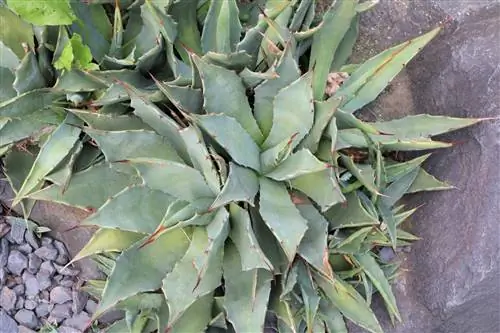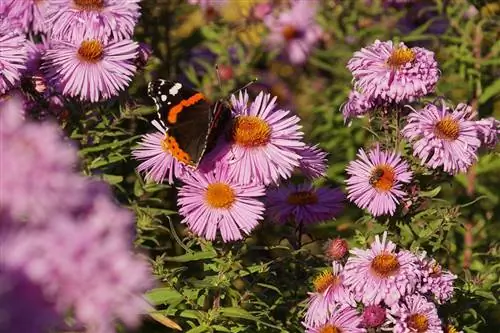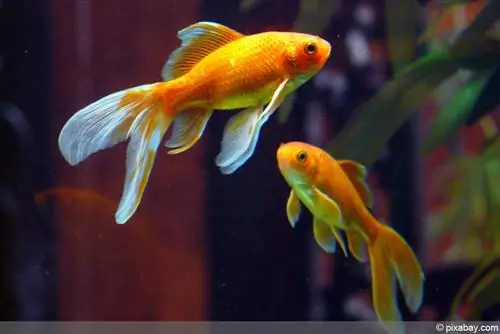- Author admin [email protected].
- Public 2023-12-17 03:39.
- Last modified 2025-01-24 12:45.
With its pointed and partly thorny leaves, the agave is an eye-catcher. Undemanding and easy to care for, the desert plant is also ideal for beginners and anyone who occasionally forgets to reach for the watering can. As frugal as the agave is, it still needs the right measures.
Agave provides the raw material for sisal and tequila - but it also makes wonderful plant decorations. There is very little that needs to be taken into account when caring for it, so it is also very suitable for beginners. However, if it is quite frugal and forgives forgetting to water, mistakes in care can quickly and long-term become noticeable. Therefore, when it comes to agave, the right measures are particularly important.
Location
The agave originally grows in desert areas and in mountainous areas, i.e. in places with high levels of sunlight. And it also needs this at its location in the garden or house. However, it must not suddenly be exposed to hours of blazing sun. It is better to first accustom the plant to a sunny location by spending two to three weeks in partial shade. If you don't take this time, you risk burns and further damage to the agave.
Substrate
Agaves are undemanding when choosing the right substrate. Normal potting soil with a good amount of sand is sufficient for them to thrive. The sand ensures that the soil remains loose and permeable. A ratio of two to three parts soil and one part quartz sand is suitable.
Pouring
When it comes to watering agave, less is more. The plant cannot tolerate waterlogging at all and even persistent moisture causes problems for it. Watering should therefore only be given when the surface of the substrate has dried thoroughly. When it comes to the type of water, however, agaves are frugal; they are even fine with hard tap water. But rain is still the better choice. In addition, watering is completely unnecessary if the agave is in the open air.
Tip:
Because checking the substrate is not easy due to the pointed leaves, you can look at the leaves themselves instead. If they lack water, they appear limp, thin and wrinkled. After watering, they recover quickly and become firm and thick again.
Fertilize
As undemanding as the agave is, it only needs a few additional nutrients. And that only in summer. From around May to September you can fertilize heavily diluted monthly or every two weeks. Liquid products for succulents and complete fertilizers for green plants are suitable.
Intersection
Basically, agaves can do without cutting. However, every now and then this measure makes sense. Namely when there are several dried leaves at the base. In pots, these promote rot and other infections, so they should be cut or torn. But only when they are completely dry. Waiting is important because the agave draws stored nutrients and water from the leaves. Fresh leaves can also be cut for further use.
Propagation
Agave can be propagated through seeds and cuttings, also known as kindles. However, obtaining the seeds is difficult because agaves only bloom once in their life. With a possible life expectancy of 100 years or more, flowering can be a long time coming.
Propagation is much quicker and easier using the so-called Kindel. These appear directly next to the mother plant in the substrate. Left to their own devices, the young shoots will gradually displace the older plant and cause it to die. This can be prevented by separating them in good time.
- If the children have at least four to five leaves, the entire root ball is freed from the substrate. Sturdy work gloves should be worn to protect against injuries.
- If there are still substrate residues on the roots, they should be rinsed off with water.
- The young shoots are now carefully separated from the mother plant using a knife that is as sharp as possible, for example a cutter or carpet knife. It is advisable to place the root ball on a smooth, firm surface.
- The child and mother plant are then placed in the substrate described above. Special growing soil is not necessary for the undemanding agave.
Repotting
Agaves can grow quite large very quickly, so repotting is more common with desert plants. This is still possible with small plants without any problems, but with larger plants it becomes difficult. For this reason, it is advisable to carry out the measure with at least two people.
Before repotting, which is best done in spring, the substrate should dry out a little. It is ideal to change the pot immediately after hibernation. Then the soil is less moist anyway and comes apart more easily. To avoid injury, a thick, sturdy tarp should be spread between the soil and the base of the plant. A blanket under the tarpaulin provides additional protection from the sharp or prickly edges of the leaves. The new pot should be large enough so that the tips of the leaves just line up with the edge or, if possible, still have some space. If enlargement is no longer possible for reasons of space, the roots can be trimmed and the lower leaves cut off.
Culture in the open air
The agave can easily be left outdoors during the summer and at temperatures above 10 °C. However, as soon as the thermometer drops in autumn, they should be brought indoors. Even though it is often mentioned otherwise, agaves are not hardy. Some species, such as agave. americana var. protoamericana can survive short periods of frost, but in the long term they suffer from low temperatures. Accordingly, planting outdoors is not recommended.
Wintering
Overwintering the agave is quite easy if its requirements are met. If the succulent is cultivated as a houseplant, it can easily stay in place. However, an overly warm place above the heater is not recommended. She still needs light and water. A cooler winter quarter is ideal for houseplants and agaves that have spent the summer outdoors. In preparation for this, watering and fertilizing should be limited. Rain should also no longer reach the plants.
The plants are moved to the cool winter quarters as soon as the temperatures are between 10 and 15 °C. The winter location in this area must also be tempered. It also needs to be as bright as possible. All that is necessary for care is to prevent the agave from drying out completely and to regularly examine the agave for pests and diseases.
Typical pests and diseases
On the disease side, agaves are only susceptible to rot. This only occurs if the substrate is kept too moist. Only a quick repotting and keeping it dry can help here. Pests are also rarely found on agave. However, different types of lice and palm weevils can occur. While the lice can be quickly removed by wiping with a damp cloth, there is currently no suitable remedy for palm weevils.
Frequently asked questions
Is agave poisonous?
When raw, agave is considered to be less toxic - however, the content varies from variety to variety. However, the plant sap can cause irritation and inflammation on the skin and mucous membranes. Small children and pets can experience further symptoms of poisoning, which can result in death if large quantities are consumed.
Why do the leaves of the agave turn yellow?
If the agave shows yellow discoloration, this is usually the first symptom of root rot, which is caused by soil that is too moist. The plant can be saved by quickly changing the substrate and drying the culture.
What you should know about agaves in brief
Caring for agaves is relatively easy. You don't even need a green thumb to grow agaves.
If you are interested in agave, you will quickly notice that there is different information regarding the number of this plant. Some sources say there are around 300 different species, while other sources say there are around 400 different sources. In any case, the agave belongs to the succulent family and its area of origin is Central America. Then the agave spread throughout the Mediterranean. The leaves of the agave are tapered to a point in almost all species with a terminal spine. The sword-shaped, fleshy and very tough leaves are arranged like rosettes.
Agaves are increasingly being placed outdoors. If you want to do this, you should slowly get the plant used to the sun. Otherwise the leaves will burn. The agave actually needs a lot and, above all, strong sun. However, if you want to perfect the care of agaves so that the agaves are cultivated very well, you should pay attention to the following at the beginning of the outdoor season: Slowly get used to direct sunlight. This means that you place the agave outdoors in a semi-shady place for the first two weeks.
In winter, the agave must definitely be brought back into the house because it is not frost-resistant. Agaves are best overwintered at a temperature of around 10 degrees Celsius to 14 degrees Celsius. During this time, the agave should be watered moderately so that it can actually maintain its rest phase.
Caring for agaves throughout the year is, as already mentioned, quite easy. Starting with the substrate. In any case, this should consist of two parts potting soil and one part sand. The agave should be watered so that the root ball of the agave is always slightly moist. However, the soil on top of the pot should always have time to dry out between waterings. Thinning with a complete fertilizer should be done approximately every two weeks. Agaves should be repotted in spring if possible. Propagating agaves is quite easy. The plant forms side shoots, also called offshoots and kindles. These are removed and planted. Water very sparingly at the beginning until the offshoots have established roots.
Caring for agaves is not rocket science, especially since the plant is very robust and rather invulnerable to insects and vermin. However, you should be careful of the terminal thorns on the leaves. You can get badly hurt by it. Particular caution should be exercised with larger agaves in conjunction with small children. Because sometimes the little ones are at eye level with the sharp thorns of the agave. And a thorn like that doesn't necessarily have to hurt a little rascal's eye.






